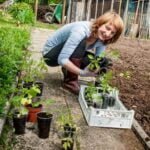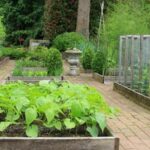Are you interested in starting your own indoor vegetable garden but don’t know where to begin? If so, you’ve come to the right place. In this comprehensive guide, we will walk you through the basics of indoor vegetable gardening for beginners, covering everything from selecting the right vegetables and ideal location to essential tools and supplies, understanding light and watering needs, maintaining healthy soil, managing pests and diseases, and finally enjoying the fruits of your gardening endeavors.
Indoor vegetable gardening can be a rewarding and fulfilling hobby for beginners looking to grow their own fresh produce in limited space. Whether you live in an apartment or have a small outdoor space, indoor vegetable gardening allows you to take control of what you eat while also adding a touch of greenery to your home. With the right guidance and knowledge, even those new to gardening can successfully grow their favorite vegetables all year round.
Throughout this article series, we will provide beginner-friendly tips and advice on how to get started with indoor vegetable gardening. By the end, you’ll feel confident enough to embrace the journey of nurturing your very own indoor garden. So whether you’re a plant enthusiast looking for a new challenge or someone eager to explore sustainable living practices, let’s dive into the world of indoor vegetable gardening together.
Selecting the Right Vegetables for Indoor Gardening
When starting indoor vegetable gardening as a beginner, it’s important to choose the right vegetables that are suitable for growing in containers or small spaces. Some vegetables thrive well indoors and can provide a bountiful harvest with the proper care and attention. As a beginner, it’s essential to select vegetables that are low-maintenance and have high chances of success in an indoor environment.
One of the most popular choices for indoor vegetable gardening beginners is herbs such as basil, parsley, chives, and mint. These herbs are versatile, easy to grow, and can be used in various culinary dishes. Cherry tomatoes are also an excellent option for indoor gardening as they do well in containers and produce delicious fruits throughout the growing season. Additionally, leafy greens like lettuce, spinach, and kale are perfect for indoor cultivation due to their compact growth habit.
It’s important for beginners to consider the space available for their indoor vegetable garden when selecting which vegetables to grow. Some plants may require more room to spread out their roots or vine, while others can thrive in smaller pots or containers. By choosing the right vegetables suited for indoor growing conditions, beginners can set themselves up for a successful and enjoyable gardening experience.
| Vegetable | Growing Conditions |
|---|---|
| Herbs (Basil, Parsley, Chives) | Compact, suitable for small containers |
| Cherry Tomatoes | Require larger containers with support for vines |
| Leafy Greens (Lettuce, Spinach, Kale) | Can thrive in smaller pots or containers |
Choosing the Ideal Location for Your Indoor Vegetable Garden
When it comes to indoor vegetable gardening for beginners, choosing the right location for your garden is crucial for the success of your plants. The ideal location will provide the best conditions for your vegetables to thrive, including sufficient light and a controlled environment. Here are some important factors to consider when selecting the perfect spot for your indoor vegetable garden.
First and foremost, you will need to find a location that receives ample sunlight. Most vegetable plants require at least 6-8 hours of sunlight per day, so it’s essential to place your garden near a window or in a room with good natural light. If natural light is limited in your home, you may want to consider using artificial grow lights to supplement the light needs of your plants.
Another important consideration is the temperature and humidity of the chosen location. Vegetables typically prefer a warm and humid environment, so avoid placing your garden in drafty areas or near air vents or heaters that could affect the temperature and humidity levels. It’s also important to ensure good air circulation in the chosen location to prevent any mold or mildew issues.
In addition to light and climate conditions, you should also consider the available space in your chosen location. Make sure there is enough room for all of your containers or planter boxes, as well as easy access for watering and maintenance.
Keep in mind that some vegetables may require more space than others, so it’s important to plan accordingly based on the types of vegetables you want to grow. By carefully considering these factors, you can ensure that your indoor vegetable garden has the best possible chance of thriving.
| Factors | Considerations |
|---|---|
| Sunlight | 6-8 hours of sunlight per day |
| Temperature & Humidity | Avoid drafty areas and maintain warmth and humidity |
| Space | Ensure enough room for containers and easy access for maintenance |
Essential Tools and Supplies for Indoor Vegetable Gardening Beginners
When starting your indoor vegetable gardening journey as a beginner, it’s important to have the right tools and supplies on hand to set yourself up for success. Here are some essential items that every indoor vegetable gardening beginner should consider:
Containers and Pots
The first step in indoor vegetable gardening is selecting the right containers and pots for your plants. Look for containers that have drainage holes to prevent waterlogging, and make sure they are the appropriate size for the vegetables you want to grow. Additionally, consider the material of the containers – plastic, ceramic, or fabric pots are popular choices for indoor gardening.
Quality Soil Mix
Choosing the right soil mix is crucial for the success of your indoor vegetable garden. Look for a high-quality potting mix specifically designed for container gardening. Avoid using regular garden soil, as it can become compacted and may not provide sufficient drainage.
Gardening Tools
Investing in a few basic gardening tools will make tending to your indoor vegetable garden much easier. A trowel, pruners, watering can, and spray bottle are all useful items to have on hand. Additionally, a small rake or hand fork can help with soil maintenance in your containers.
Grow Lights
Since light conditions indoors may not be sufficient for some vegetables, considering investing in grow lights is essential for indoor vegetable gardening beginners. LED grow lights are energy-efficient and provide the necessary spectrum of light for plant growth. Be sure to position them at an appropriate distance from your plants to prevent burning.
By having these essential tools and supplies on hand, you’ll be well-equipped to start your indoor vegetable garden as a beginner. With proper planning and preparation, you can set yourself up for a successful harvest of fresh and healthy produce right from the comfort of your home.
Understanding Light and Watering Needs for Indoor Vegetable Plants
When it comes to indoor vegetable gardening for beginners, understanding the light and watering needs of your plants is crucial for their growth and productivity. In this section, we will explore the important factors to consider when providing the right amount of light and water for your indoor vegetable garden.
Light Requirements for Indoor Vegetables
Different vegetable plants have varying light requirements, so it’s essential to know the specific needs of the vegetables you intend to grow. Most vegetables require at least 6-8 hours of sunlight per day. If natural sunlight is limited in your indoor space, consider using grow lights to supplement the light needs of your plants. Positioning your plants near south or west-facing windows can also help maximize their exposure to sunlight.
Watering Needs for Indoor Vegetable Plants
Overwatering or underwatering can be detrimental to the health of your indoor vegetable plants. It’s important to monitor the moisture levels in the soil regularly and adjust your watering routine accordingly. As a general rule, water your vegetable plants when the top inch of soil feels dry to the touch.
Be mindful not to let the soil become waterlogged, as this can lead to root rot and other issues. Using a watering can with a spout or a spray bottle can help control the amount of water you apply, especially for smaller containers.
Humidity Considerations
In addition to watering, humidity levels can also impact the health of your indoor vegetable plants. Some vegetables thrive in higher humidity environments, while others prefer drier conditions. To create an optimal growing environment, consider using a humidity tray or misting the air around your plants if needed. Monitoring and adjusting humidity levels can contribute to successful indoor vegetable gardening for beginners.
Understanding and catering to the specific light and watering needs of your indoor vegetable plants will set you on the path towards a bountiful harvest as an aspiring indoor vegetable gardening beginner.
Tips for Maintaining Healthy Soil in Container Gardening
When it comes to indoor vegetable gardening, maintaining healthy soil is essential for the success of your plants. Container gardening, in particular, requires special attention to the soil in order to provide the right nutrients and support for your vegetables. Here are some tips for beginners looking to maintain healthy soil in their indoor vegetable garden:
- Choose the right potting mix: Select a high-quality potting mix that is specifically formulated for container gardening. Look for a mix that provides good drainage and aeration, as well as essential nutrients for plant growth.
- Fertilize regularly: Indoor vegetable plants rely on you to provide them with the necessary nutrients, so regular fertilization is key. Consider using a slow-release fertilizer or organic options to keep your soil rich and fertile.
- Monitor moisture levels: Overwatering or underwatering can both be detrimental to the health of your indoor vegetable plants. Keep an eye on the moisture levels of your soil and adjust your watering schedule accordingly.
In addition to these tips, it’s important to regularly inspect your plants for any signs of nutrient deficiencies or soil issues. Remember that healthy soil is the foundation for thriving indoor vegetable plants, so taking the time to care for your soil will pay off in bountiful harvests of fresh produce.
By following these tips and being attentive to the needs of your indoor vegetable garden, you can ensure that your plants have a healthy environment to grow and thrive in.
Common Pests and Diseases in Indoor Vegetable Gardening and How to Manage Them
When starting your indoor vegetable garden as a beginner, it’s important to be aware of the potential pests and diseases that can affect your plants. Here are some common issues to watch out for and how to manage them:
1. Aphids: These tiny insects can quickly infest your indoor garden, sucking the sap from plants and causing damage. To control aphids, you can introduce natural predators like ladybugs or use insecticidal soap.
2. Powdery Mildew: This fungal disease appears as a white powdery substance on the leaves of plants, usually caused by high humidity and poor air circulation. To prevent powdery mildew, ensure proper ventilation in your indoor garden and avoid overcrowding plants.
3. Spider Mites: These pests are barely visible to the naked eye but can cause significant damage to your plants by sucking their juices. Regularly spraying your plants with water can help reduce spider mite infestations, or you can use insecticidal soap as a treatment.
4. Fungal Gnats: These tiny flies are attracted to moist soil and can lay eggs in the growing medium of your indoor garden. To prevent fungal gnat infestations, allow the top layer of soil to dry out between waterings, or use biological controls like predatory nematodes.
By being proactive and monitoring your indoor vegetable garden regularly, you can effectively manage common pests and diseases without using harsh chemicals that may be harmful to your plants or the environment. Happy gardening.
Harvesting and Enjoying the Fruits of Your Indoor Vegetable Gardening Endeavors
Once you have successfully nurtured your indoor vegetable garden, it is time to enjoy the fruits of your labor. Harvesting your vegetables is a rewarding experience that brings satisfaction and freshness to your home. As a beginner in indoor vegetable gardening, it is essential to understand the proper techniques for harvesting and preserving your produce.
When it comes to harvesting, timing is crucial. Different vegetables have specific signs that indicate they are ready for picking. For example, tomatoes should be harvested when they are fully colored and firm, while leafy greens like lettuce and spinach can be harvested at any stage of growth. It is important to research the optimal harvesting times for each type of vegetable you are growing to ensure the best flavor and quality.
After harvesting your vegetables, proper storage and preservation methods are crucial in maintaining their freshness. Some vegetables can be stored in the refrigerator for extended periods, while others may require immediate consumption or preservation through methods such as canning or freezing. As a beginner in indoor vegetable gardening, it may take some trial and error to find the best preservation practices for your specific produce, but the learning process is all part of the journey.
Lastly, enjoying the fruits of your indoor vegetable gardening endeavors also involves sharing your harvest with friends and loved ones. Nothing quite compares to the satisfaction of serving a meal made with homegrown produce. Sharing your bounty with others not only spreads joy but also encourages them to embrace the practice of indoor vegetable gardening themselves.
Overall, harvesting and enjoying the produce from your indoor vegetable garden is a gratifying experience that marks an important milestone in your journey as a beginner gardener. It provides not only nourishment but also a sense of accomplishment and pride that comes from nurturing living plants into delicious food on your own windowsill or countertop garden space.
Conclusion
In conclusion, embarking on the journey of indoor vegetable gardening as a beginner can be both rewarding and fulfilling. By selecting the right vegetables, choosing an ideal location, and understanding the essential tools and supplies needed, you are setting yourself up for success. Additionally, paying attention to the light and watering needs of your plants, maintaining healthy soil, and being prepared to manage common pests and diseases will contribute to the overall health and productivity of your indoor garden.
As a beginner in indoor vegetable gardening, it’s important to remember that this is a learning experience. You may encounter challenges along the way, such as initial failures or unexpected setbacks with your plants. But don’t be discouraged. Every setback is an opportunity to learn and improve your skills as a gardener. With patience and dedication, you will eventually reap the rewards of your efforts by harvesting and enjoying the fruits of your indoor vegetable gardening endeavors.
Furthermore, don’t hesitate to seek guidance from experienced gardeners or resources online to enhance your knowledge and skills in indoor vegetable gardening. Remember that every gardener was once a beginner too, so embrace this journey with enthusiasm and let it bring you joy as you nurture your indoor vegetable garden from seedlings to bountiful harvests. Whether for personal enjoyment or sustainable living, indoor vegetable gardening as a beginner can provide endless benefits for both mind and body.
Frequently Asked Questions
How Do You Start an Indoor Vegetable Garden for Beginners?
Starting an indoor vegetable garden for beginners involves first selecting a suitable location with access to sunlight, choosing the right containers and soil, and deciding which vegetables to grow. It’s important to consider factors like water drainage, temperature, and space before getting started.
What Vegetables Should Be Started Indoors?
Some vegetables that are best started indoors include tomatoes, peppers, lettuce, spinach, kale, and herbs like basil and parsley. These plants tend to thrive when given a head start indoors before being transplanted outside once the weather warms up.
What Is the Best Indoor Garden for Beginners?
The best indoor garden for beginners is often a container garden, using pots or raised beds placed near a sunny window or under grow lights. This type of garden allows for more control over soil quality, watering, and temperature regulation.
Additionally, starting with easy-to-grow vegetables like lettuces or herbs can help beginners gain confidence in their gardening skills before expanding to more challenging plants.

If you’re looking to get into vegetable gardening, or are just looking for some tips on how to make your current garden better, then you’ve come to the right place! My name is Ethel and I have been gardening for years. In this blog, I’m going to share with you some of my best tips on how to create a successful vegetable garden.





